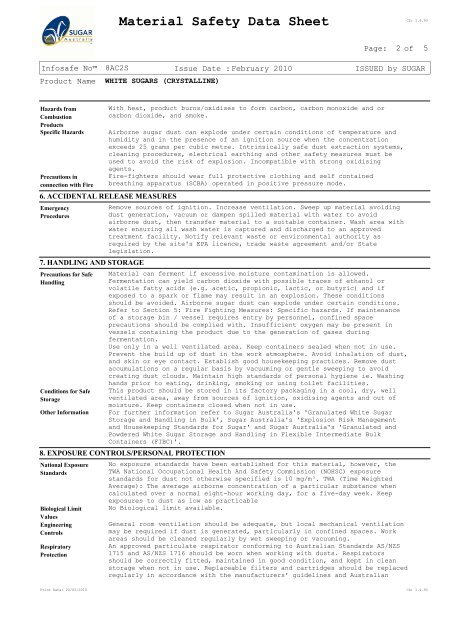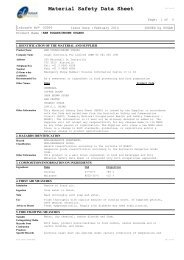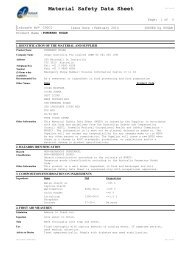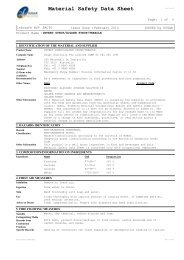White Sugar - Sugar Australia
White Sugar - Sugar Australia
White Sugar - Sugar Australia
You also want an ePaper? Increase the reach of your titles
YUMPU automatically turns print PDFs into web optimized ePapers that Google loves.
Material Safety Data Sheet<br />
Page: 2<br />
CS: 1.4.93<br />
Infosafe No 8AC2S Issue Date : February 2010 ISSUED by SUGAR<br />
Product Name : WHITE SUGARS (CRYSTALLINE)<br />
Hazards from<br />
Combustion<br />
With heat, product burns/oxidises to form carbon, carbon monoxide and or<br />
carbon dioxide, and smoke.<br />
Products<br />
Specific Hazards Airborne sugar dust can explode under certain conditions of temperature and<br />
humidity and in the presence of an ignition source when the concentration<br />
exceeds 25 grams per cubic metre. Intrinsically safe dust extraction systems,<br />
cleaning procedures, electrical earthing and other safety measures must be<br />
used to avoid the risk of explosion. Incompatible with strong oxidising<br />
agents.<br />
Precautions in Fire-fighters should wear full protective clothing and self contained<br />
connection with Fire breathing apparatus (SCBA) operated in positive pressure mode.<br />
6. ACCIDENTAL RELEASE MEASURES<br />
Emergency<br />
Procedures<br />
7. HANDLING AND STORAGE<br />
Precautions for Safe<br />
Handling<br />
Conditions for Safe<br />
Storage<br />
Remove sources of ignition. Increase ventilation. Sweep up material avoiding<br />
dust generation, vacuum or dampen spilled material with water to avoid<br />
airborne dust, then transfer material to a suitable container. Wash area with<br />
water ensuring all wash water is captured and discharged to an approved<br />
treatment facility. Notify relevant waste or environmental authority as<br />
required by the site's EPA licence, trade waste agreement and/or State<br />
legislation.<br />
Material can ferment if excessive moisture contamination is allowed.<br />
Fermentation can yield carbon dioxide with possible traces of ethanol or<br />
volatile fatty acids (e.g. acetic, propionic, lactic, or butyric) and if<br />
exposed to a spark or flame may result in an explosion. These conditions<br />
should be avoided. Airborne sugar dust can explode under certain conditions.<br />
Refer to Section 5: Fire Fighting Measures: Specific hazards. If maintenance<br />
of a storage bin / vessel requires entry by personnel, confined space<br />
precautions should be complied with. Insufficient oxygen may be present in<br />
vessels containing the product due to the generation of gases during<br />
fermentation.<br />
Use only in a well ventilated area. Keep containers sealed when not in use.<br />
Prevent the build up of dust in the work atmosphere. Avoid inhalation of dust,<br />
and skin or eye contact. Establish good housekeeping practices. Remove dust<br />
accumulations on a regular basis by vacuuming or gentle sweeping to avoid<br />
creating dust clouds. Maintain high standards of personal hygiene ie. Washing<br />
hands prior to eating, drinking, smoking or using toilet facilities.<br />
This product should be stored in its factory packaging in a cool, dry, well<br />
ventilated area, away from sources of ignition, oxidising agents and out of<br />
moisture. Keep containers closed when not in use.<br />
Other Information For further information refer to <strong>Sugar</strong> <strong>Australia</strong>'s 'Granulated <strong>White</strong> <strong>Sugar</strong><br />
Storage and Handling in Bulk', <strong>Sugar</strong> <strong>Australia</strong>'s 'Explosion Risk Management<br />
and Housekeeping Standards for <strong>Sugar</strong>' and <strong>Sugar</strong> <strong>Australia</strong>'s 'Granulated and<br />
Powdered <strong>White</strong> <strong>Sugar</strong> Storage and Handling in Flexible Intermediate Bulk<br />
Containers (FIBC)'.<br />
8. EXPOSURE CONTROLS/PERSONAL PROTECTION<br />
National Exposure<br />
Standards<br />
Biological Limit<br />
Values<br />
Engineering<br />
Controls<br />
Respiratory<br />
Protection<br />
No exposure standards have been established for this material, however, the<br />
TWA National Occupational Health And Safety Commission (NOHSC) exposure<br />
standards for dust not otherwise specified is 10 mg/m³. TWA (Time Weighted<br />
Average): The average airborne concentration of a particular substance when<br />
calculated over a normal eight-hour working day, for a five-day week. Keep<br />
exposures to dust as low as practicable<br />
No Biological limit available.<br />
General room ventilation should be adequate, but local mechanical ventilation<br />
may be required if dust is generated, particularly in confined spaces. Work<br />
areas should be cleaned regularly by wet sweeping or vacuuming.<br />
An approved particulate respirator conforming to <strong>Australia</strong>n Standards AS/NZS<br />
1715 and AS/NZS 1716 should be worn when working with dusts. Respirators<br />
should be correctly fitted, maintained in good condition, and kept in clean<br />
storage when not in use. Replaceable filters and cartridges should be replaced<br />
regularly in accordance with the manufacturers' guidelines and <strong>Australia</strong>n<br />
Print Date: 20/05/2010 CS: 1.4.93<br />
of<br />
5





